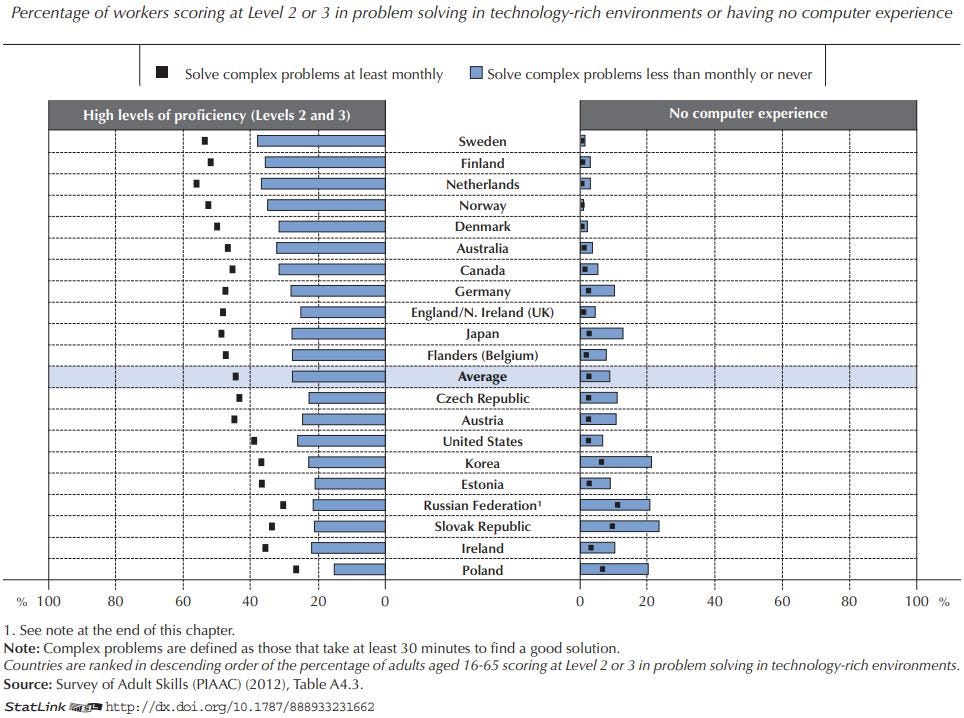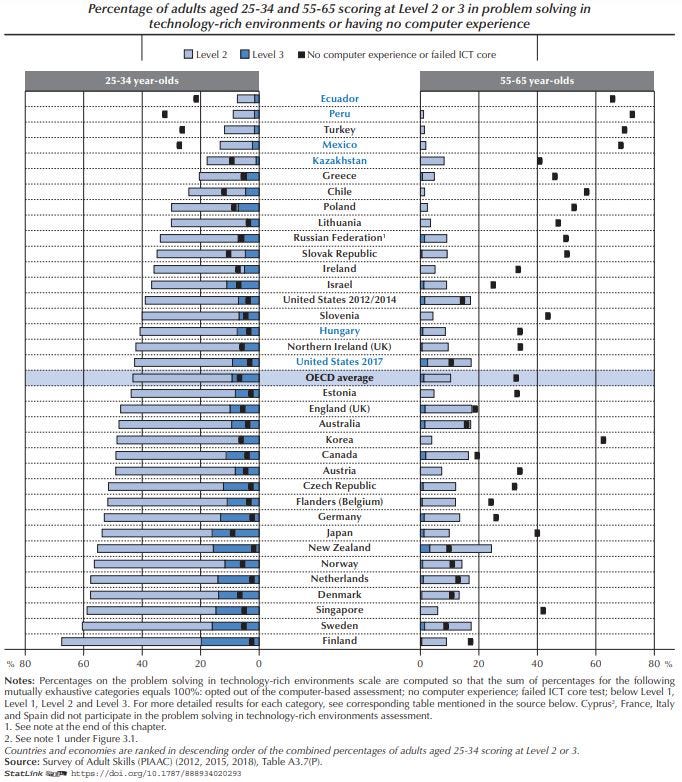As the demand for non-routine, high-skilled jobs grows, and information and communications technologies permeate every aspect of life, the ability to manage information and solve problems using digital technology and communication tools has become crucial. Proficiency in problem solving in technology-rich environments reflects the ability to use digital technology, communication tools and networks to acquire and evaluate information, communicate with others and perform practical tasks. To demonstrate proficiency in this domain, adults must have basic computer skills such as typing on a keyboard, using a mouse, drag and drop content. The performance of those who took the assessment is classified into four levels of proficiency.
Adult problem solving skills
The first cycle of the Survey of Adult Skills assessed problem solving in technology-rich environments. It examined the intersection of cognitive capacities required to solve problems and the use of information and communication technologies.

Key messages
Proficiency in problem solving in technology-rich environments is associated with higher rates of labour force participation and higher wages, even after accounting for other factors. Adults with no computer experience are less likely to participate in the labour force and when they do participate, they often receive lower wages.
On average, across OECD countries that participated in PIAAC, 43 percent of adults scored at Level 1 or below on the problem solving in technology-rich environments proficiency scale. At Level 1, adults can only complete tasks in which the goal is explicitly stated and in a single and familiar environment. Moreover, 26 percent of adults across OECD countries did not participate in the assessment, for lack of either ability (16 percent) or willingness (10 percent) to use a computer.
Context
Engaging with problem solving at work is important
Workers who more frequently engage in complex problem-solving tasks tend to have higher proficiency in problem-solving in technology-rich environments. Specifically, 45% of those who frequently tackle complex problems demonstrate proficiency at Level 2 or 3 in this domain. In contrast, only 28% of those who do so less than once a month or never scored similarly.
Problem-solving proficiency and computer experience, by frequency of complex problem solving

Older adults struggle with problem solving in digital environments
Only some 10% of older adults (aged 55-65) displayed high levels of proficiency in in problem solving in technology-rich environments. In contrast, more than 40% of younger adults (aged 25-34) scored similarly. Moreover, older adults were much more likely to lack the basic digital skills necessary to take the assessment.
Problem-solving proficiency among younger and older adults

Related publications
-
 24 April 2024
24 April 2024
Programmes and projects
-
The Survey of Adult Skills, a product of the PIAAC, measures adults’ proficiency in literacy, numeracy and the ability to solve problems in technology-rich environments.Learn more
-
The OECD Indicators of Education Systems (INES) programme seeks to gauge the performance of national education systems through internationally comparable data.Learn more
-
The Education Policy Outlook is an analytical observatory that monitors the evolution of policy priorities and policy developments from early childhood education to adult education, mainly among OECD education systems, to provide a comparative understanding of how policies are evolving, and how they can be best implemented or improved over time.Learn more
-
The OECD’s programme on education and skills policy support policymakers in their efforts to achieve high-quality lifelong learning, which in turn contributes to personal development, sustainable economic growth, and social cohesion.Learn more
-
PISA is the OECD's Programme for International Student Assessment. PISA measures 15-year-olds’ ability to use their reading, mathematics and science knowledge and skills to meet real-life challenges.Learn more






